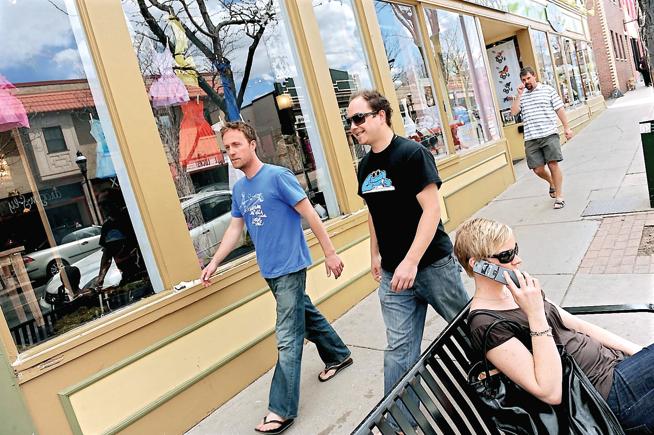
Members of our Community Editorial Board, a group of community residents who are engaged with and passionate about local issues, respond to the following question: As part of the city’s effort to make Boulder more accessible and walkable, the City Council agreed in a recent meeting to relax decade-old restrictions on restaurants in the University Hill neighborhood. Your take?
On the surface, relaxing regulations and making the Hill a walkable neighborhood sounds great. It begs the question of why we ever discouraged such a thing. The code amendment project strives to align our regulations with our comprehensive plan. Brilliant. Make our regulations more understandable? Sounds reasonable. But reducing the closing time on restaurants doesn’t make a neighborhood walkable. It’s already walkable.
What is a “walkable neighborhood” anyway? This is when people can “access essential services and amenities by foot.” In Boulder, we’ve defined it as a 15-minute walk, maybe a half mile or so. So … what are essential services? Restaurants, according to this revamping of the use tables.
In the early ’80s when I went to school at CU, I lived near University and Broadway. My roommates and I would do the occasional trip to King Soopers for groceries, but for small things, we’d just walk to Bova’s on that corner. I learned how to play Donkey Kong at a hotdog/gamer restaurant and we occasionally went to Tulagi for music and dancing. The Boulder Mountaineer was on that corner as well and supplied me with climbing gear and inspiration. The CU bookstore was just a bit south, also on Broadway. That was a walkable neighborhood.
All these “essential services and amenities” were nice, but what truly made this a walkable neighborhood, at least for me, was that my “job” was studying engineering at CU, and I could walk there. The ideal walkable neighborhood has residents walking to work. I don’t see that here in Boulder, where our skills are too diverse and our density (partly due to height restrictions) is too low. To really succeed at creating walkable neighborhoods requires density and, for better or worse, people in the western U.S. value space over walkability.
I’m all for reducing the restrictions on businesses whether that’s on the Hill or anywhere else in Boulder. But the more meaningful change to the zoning code was to allow duplexes and triplexes in the business transition zones. This allows more income-diverse residents to enjoy the walkable Hill.
Bill Wright, bill@wwwright.com
As we reconsider land-use regulations we must not forget that the current configuration of Boulder is the product of decades upon decades of anachronistic laws and practices. In this context, plans to reconceptualize our city present an incredible opportunity to redress historical wrongs without the impossible burden of starting from scratch. My point is perhaps best illustrated by an exercise used at an anti-racism workshop. The facilitators asked African-American participants to go into a separate room, where they played Monopoly in small groups. After an hour, the white participants were asked to join the games in progress. Not surprisingly, the white participants complained: All the good properties had already been claimed by those allowed to start the game first! (Had this exercise-qua-metaphor involved indigenous people, the white participants would have simply removed the original players and redistributed their houses and hotels.)
It’s time to actively ameliorate the impacts of such practices as red-lining, the exclusion of people of color from loan programs and the frank theft of land belonging to indigenous peoples. This requires that we challenge the primary use of the geographic distinctions that arose from discriminatory practices. Otherwise, we risk simply perpetuating the current economic and social divisions.
Specifically, the idea of 15-minute cities works only if each “city” has adequate resources. It is hard to imagine how this would happen when there is inadequate funding for even centralized public services. Rather than treat the current positions on the Monopoly board that is Boulder as somehow “natural” and therefore appropriate to use as a main baseline for city planning, I suggest we adopt a multi-level approach that seeks equity at city, neighborhood and individual levels using the resources available at each level. For example, building a local public mental health clinic will accomplish nothing if it has the same long waiting list as the main mental health facility. In this instance, physical accessibility is only part of the problem; the main problem is that public mental health services are underfunded — regardless of their location. A multi-level approach could involve improving public transportation in areas with low car ownership, which would give residents without cars the chance to access centralized but better-funded resources. It might also involve offering incentives for businesses that are located in underserved areas and low-interest loans to victims of previous exclusionary practices.
Isn’t Thanksgiving week the perfect time to think about how land-use regulations can shape history?
Elyse Morgan, emorgan2975@gmail.com
Justin Bibb, the current mayor of Cleveland, my hometown, is championing “15-minute walkable neighborhoods.” (Full disclosure: he received his undergraduate degree in Urban Studies at the university where I teach, mostly remotely.) He advocates policies that enable residents to have easy access to basic necessities and amenities within a short walk from their homes or workplaces.
Similarly, while living and working in Helsinki, I was a member of a neighborhood committed to long-term planning and walkable communities.
What lessons can be gleaned from having a birds-eye view of 15-minute communities? How then to revitalize a chaotic neighborhood like Boulder’s University Hill?
Each locale is, of course, distinctive. Boulder has its own special history, vibrant culture and regulatory environment. But there are common challenges in terms of sustainability, safety, density, affordability and mobility.
Kudos to Boulder officials and urban planners for adopting a data-driven approach. Their goal is to simplify and streamline the process of upgrading. It is meant to be transparent, conducted in a respectful manner and foster community engagement.
Trained in statistical analysis, I believe in rigorous research based on solid evidence. I’m also aware of the limitations of descriptive data. How are the key indicators selected? What assumptions are embedded in Use Tables and Standards?
To avoid a technocratic approach to planning, it is important to supplement big data with the inter-ocular test: If an egregious problem or flawed policy hits you smack between the eyes, then address it.
Critics of walkable neighborhoods are rightly concerned about costs. Who will pay for changes in land use? How will zoning restrictions — say, for single-family homes — be altered? Given a fractious civic climate in this country, can Boulder summon a shared political will? Additionally, extremists argue that 15-minute neighborhoods are enclaves, ghettos that confine residents, camps for surveilling residents.
Nonetheless, my experience with “15-minute walkable neighborhoods” prizes the health benefits of walking, biking and using public transportation rather than automobiles. There is a reduction in pollution and a heightened sense of community. Walkable neighborhoods offer coffee shops, grocery and other retail stores, offices, libraries, and child care facilities, all nearby. As in Helsinki, small specialty shops, not only look-alike chain stores, can flourish.
Hardly a panacea, “15-minute walkable neighborhoods” are an invitation to re-imagine the future of our city. Both a global and potentially homegrown strategy for urban revitalization, it is the politically wise and morally right policy for Boulder.
Jim Mittelman, jhmittelman@yahoo.com


